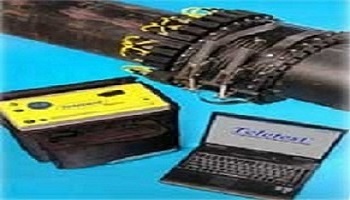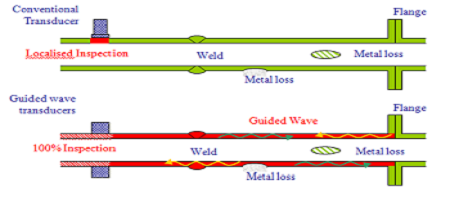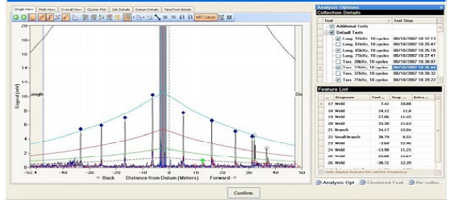Long Range Ultrasonic Testing:
For Pipeline Inspection;
Inspection through insulation opens unexpected opportunities: LRUT is primarily a screening tool. The aim of the inspection is to test long lengths of pipe rapidly from a single test point with 100% coverage of the pipe wall and to identify areas of corrosion or erosion for further evaluation using other NDT techniques such as radiography or conventional ultrasonic. The technique is equally sensitive to metal loss on both the outside and inside surfaces of the pipe. The system is entirely computer controlled, data acquisition and display/analysis being performed using a personal computer. Long-Range ultrasonic Non Destructive Testing Technology was developed for detecting corrosion and metal loss in pipe work. Its initial application was for detecting corrosion under insulation in petrochemical plant pipe-work, but has found widespread use in other inspection situations where pipes or tubes are not accessible, for example where they are buried, encased in a sleeve or elevated above the ground.
Advantages:
· Low-cost screening with 100% coverage.
· Focusing capability to evaluate corrosion distribution around pipe circumference.
· Test range under ideal conditions can achieve 300m or more.
· Testing of pipes from 1.5" up to 48” diameter.
· Reliable and accurate detection.
· Ideal where conventional testing is impossible or very costly e.g. clamped, insulated, elevated,
leeved or buried pipes.
· Operating Temperature -5⁰C to 100⁰C Inspection on insulated pipes without taking of the insulation (only where equipment will be fixed).
Equipment:
The equipment has the added feature of focusing the sound energy into a specific region of the pipe to measure the distribution of the corrosion around the circumference at a specific distance.
This is especially valuable for inaccessible pipe work allowing the end-user to make a more informed decision about the need for further action.
Process:
· Low-frequency ultrasound is transmitted and received from a single location.
· The guided waves travel long distances, even in submerged or insulated pipes.
· Response from flaws is a function of their depth and circumferential extent.
· Focusing allows ultrasound energy to be concentrated into a small region of pipe for Detailed localized inspection.
Applications:
- Pipe types:
Seamless, Longitudinally and spiral welded.
- Pipe materials:
Ferritic, stainless steel and any other material.
Pipe situations:
- Buried
- Air-to soil interface
- Air-to water interface
- Elevated on racks
- Sleeved in road crossings
- Wall, bund or berm penetrations
Pipe coatings:
- Foam or mineral wool.
- PVC, epoxy, coal tar epoxy.
- Paint.
- Bitumastic wrapping.
Pipe duties:
- Transmission and distribution lines.
- Refinery and chemical plants.
- Offshore risers.
- Jetty lines.
- Tank farm link lines.
- Power plant service pipes.
- Storage sphere support legs.
Flaws found:
- External corrosion
- Corrosion under insulation (CUI)
- Internal corrosion or erosion
- Environmental cracking




